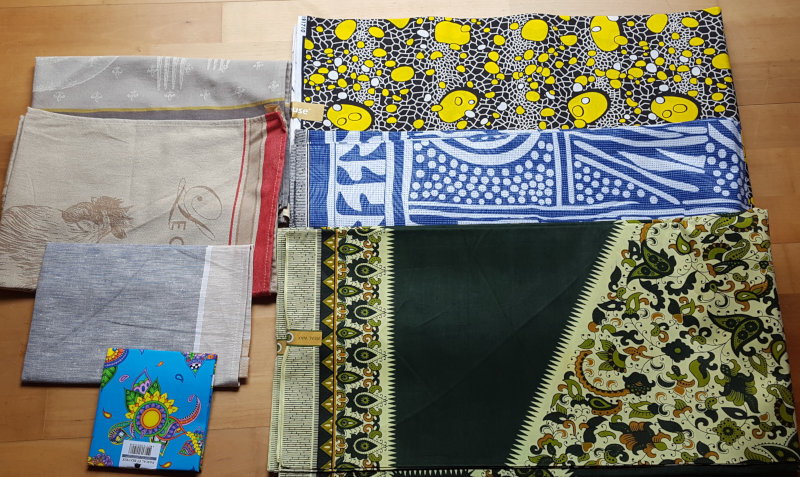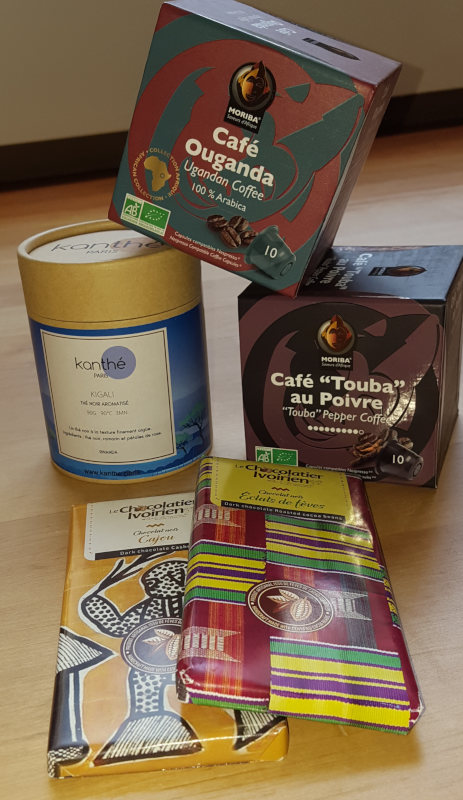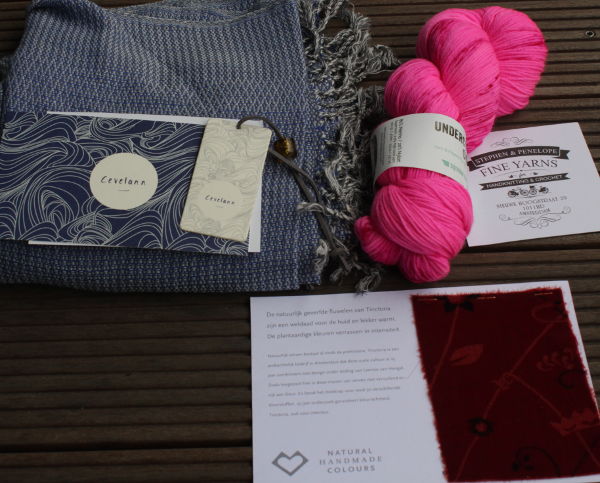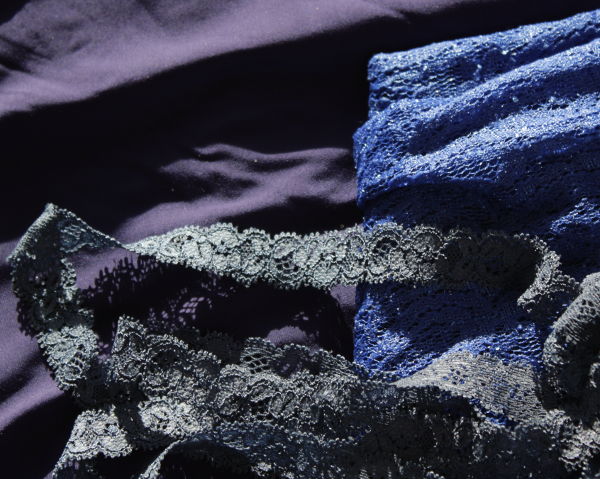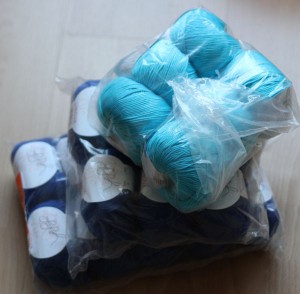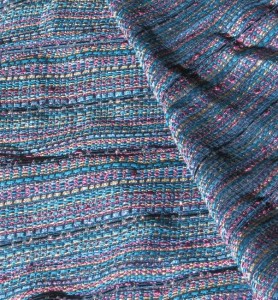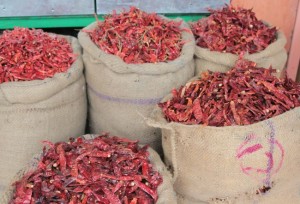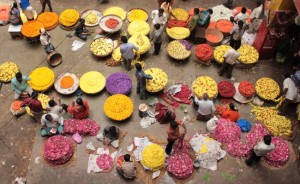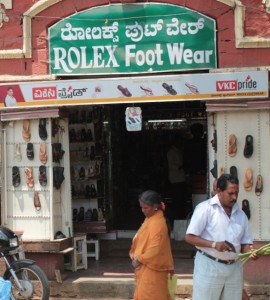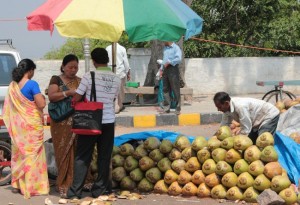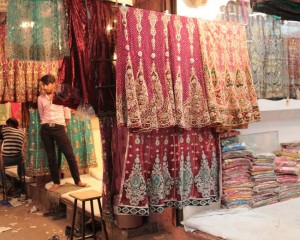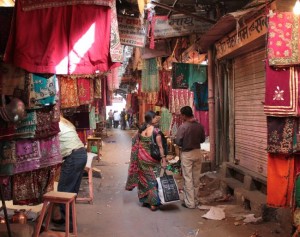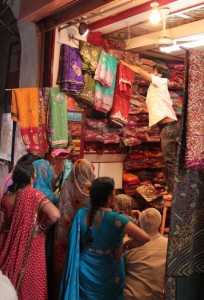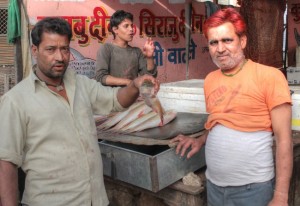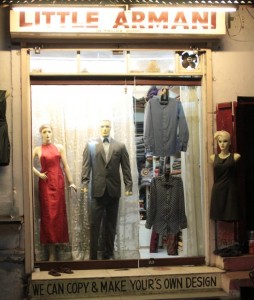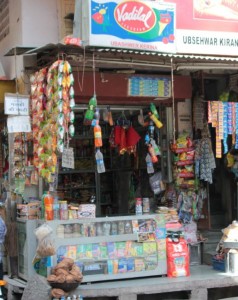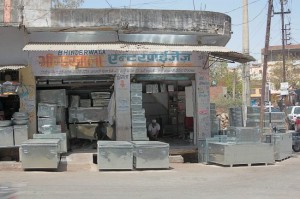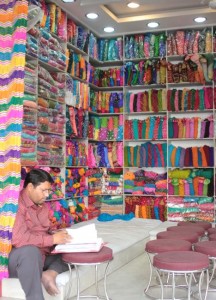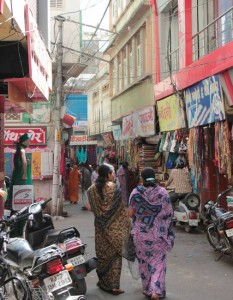Eigentlich hätte ich beim letzten Besuch in Paris ja keine Stoffe gebraucht. Aber dann war ich bei Freunden zu Besuch, die ihren Garten umgestaltet haben, wo es jetzt eine “Lounge” Area geben soll. Die soll aber auch gemütlich werden die Lounge, als soll sie Kissen und so was bekommen.
Nachdem ich Gestell, Dach aus Weidenmatten und die Vorhänge aus Holzperlen als Sichtschutz gesehen hatte, dachte ich ganz spontan an afrikanische Wax Stoffe. (Die ursprünglich gar nicht aus Afrika kommen, sondern nur von schlauen Europäeren dort popularisiert wurden. Aber anderes Thema.)
Die Wax Stoffe haben überdies den Vorzug, dass es sie in recht günstiger Variante gibt, und meist sind sie eher aus fester Baumwolle. Also grade richtig für den Garten.
Frohgemut zog ich also los, erstes Geschäft in der Rue Poulet. Große Auswahl, vieles zu kleinen Preisen. Die Garten Lounge soll Papas Refugium werden, Mama hatte eine Idee, welche Farbe er mögen könnte. Ich schick mal die ersten drei Bilder in dieser Farbe. Dann fällt mein Blick auf die grünen Ranken (die ich mir gut zum Ort vorstellen kann), noch ein Photo… Mann loggt ein… Stoffsuche für die Lounge beendet. (Das ist der dunkelgrüne vorne rechts. So ein Coupon liegt übrigens standardmäßig etwa 112 cm breit und ist 6 yard lang. Damit lässt sich was machen.)
Öh wie jetzt? Was mach ich denn mit dem Rest vom Tag? Geht ja gar nicht, der war doch dafür eingeplant.
Aber gut, da ich schon mal in der Ecke war, dachte ich, guckst du mal weiter, ob in der Rue Polonceau auch noch so viele afrikanische Stoffläden sind. Die Anwort lautet: Ja. Auch wenn die meisten davon Bazin verkaufen (Was schlichtweg Damast ist, nur sehr bunt. Und die angesagte Marke ist “Mama Getzner”, geprüfte Qualität aus Österreich…), auch Wax war zu finden. Und da sprang mich der schwarz-weiße mit den knallig gelben Punkten förmlich an. (Giraffe auf LSD oder so.) Ich habe nicht den leisesten Schimmer, was der mal wird, weil mir keine der drei Farben so wirklich steht… aber der musste mit. Und der blaugemusterte in der Mitte ist ungefähr das, was ich vor einigen Jahren für meine Terrasse gesucht hatte. Ewig werden die aktuellen Kissen ja auf der Terrasse nicht leben, da kann ich doch schon mal den nächsten Stoff… oder? (Und wenn nicht… blau geht immer, man kann auch prima Pyjamas aus dem Stoff machen.)
Und wenn man schon mal im Viertel Goutte d’Or ist, ist der Weg hoch zum Stoffviertel am Montmarte nicht mehr weit. Noch mal drei Geschirrtücher, weil ich für einen bestimmten Zweck eines brauche, wo der Vorrat nichts passendes her gibt und natürlich noch ein Fat Quarter für meinen Quilt. Muß ja weiter gehen.
Mit den Stoffen war ich durch. Aber wenige Tage später am Boulevard Beaumarchais (und auf der Suche nach was ganz anderem), drückt mir eine Frau einen Flyer in die Hand. Da drüben in der Seitenstraße ist grad Pop Up Store für einige Tage. Ja, danke… ich erst Mal in den Laden, in den ich wollte.
Nachdem der das, was ich wollte auch nicht so hatte, wie ich es wollte, dachte ich, guck doch mal in den Pop Up Laden. Ist bestimmt irgendein Kunsthandwerk, kann ja interessant sein.
Kunsthandwerk in gewisser Weise, aber essbar. (Schon mal gut, das bleibt nicht rumstehen). Und auch alles aus Afrika. Also das Thema meiner Woche.
Die Schokolade und der Kaffee kommen von Afriyummy. (Was als Unternehmen nicht annähernd so groß ist, wie die Webseite es vielleicht scheinen lässt…) Die Schokoladen werden tatsächlich in Afrika von einem Chocolatier hergestellt und dann exportiert (im Gegensatz zu den meisten anderen “Regionalen” Schololaden kommt als nicht nur der Kakao aus einer bestimmten Region, sondern die Wertschöpfung bleibt zu einem großen Teil im Produktionsland, was ich nur fair finde). Außerdem werden Frauen vor Ort zu Chocolatiers ausgebildet, um dort ein lokales Handwerk zu schaffen.
Cafés gab es praktischerweise für die Nespresso. Besonders interessiert mich der mit Pfeffer gewürzte. (Und zu meiner Entschuldigung sei gesagt… das ist nicht alles für mich, ein Teil wird verschenkt.)
Außerdem hatten sich auch noch leckere karibische Konfituren. Aber die habe ich mir verkniffen, der Koffer muß ja tragbar bleiben. Und die Wax Stoffe sind zwar schön flach, aber sie wiegen dann doch einiges.
Und auch einem der Tees von Kanthé konnte ich dann nicht widerstehen. Hier werden die Tees von der Firmeninhaberin selber in Paris komponiert und hergestellt, die Zutaten kommen jedoch aus Afrika. Dabei arbeitet Maimouna Kanté (und das ist tatsächlich die Frau von den Bildern auf ihrer Webseite…) mit ausgewählten landwirtschaftlichen Betrieben in verschiedenen Regionen Afrikas zusammen. Es gibt nicht nur Schwarztees, sondern auch Grüntees, Roiboos und Kräutertees. Gerochen haben sie alle gut, nur trinke ich aktuell nicht so viel Tee, deswegen habe ich mich sehr zusammen genommen.
Ja, geplant war ein afrikanischer Stoff für meine Freunde und ein “Souvernirstoff” für meinen Quilt. Und dann ist halb Afrika im Koffer gelandet. (Andererseits… dafür liebe ich Paris. Nur gut drei Stunden mit dem Zug und ich kann auf einem anderen Kontinent sein. Zumindest ein bisschen.)

